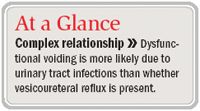Article
Infection, not VUR, tied to dysfunctional voiding
Clearwater Beach, FL-In the complex relationship betweendysfunctional voiding in children and the role of vesicoureteralreflux, researchers suggest that the real problem is preventingurinary tract infections.


Describing his research gleaned from studies of more than 2,000 children, Dr. Steinhardt said, "We are unable to discern that vesicoureteral reflux impacts the development of dysfunctional voiding, no matter what the laterality of vesicoureteral reflux, the age of diagnosis, patients' gender, or-in infants-the grade of vesicoureteral reflux."

Dr. Steinhardt said that analysis of his database shows that patients with congenital reflux do not necessarily develop dysfunctional voiding. On the other hand, he said there is a positive association between dysfunctional voiding and urinary tract infections that is independent of the age of the first infection.
"The role of each of these conditions-dysfunctional voiding, urinary tract infections, and vesicoureteral reflux-is very complex," explained Yves Homsy, MD, clinical professor of surgery and pediatrics at the University of South Florida and Children's Urology Group, Tampa.
"Determining which of these conditions is related to another remains controversial," he said, adding that reflux is associated with an abnormality of the trigone, which may have an impact on the mechanisms of bladder neck function and which, in turn, may be disturbed by urinary tract infections, thus linking it to dysfunctional voiding.
However, Dr. Homsy noted that Dr. Steinhardt presented a great deal of very pertinent data that may help explain the conditions' relationship.
"We need to look at that data more closely to determine how a clear-cut cause-effect relationship among the conditions can be established," Dr. Homsy said.
Effects of VUR analyzed
Dr. Steinhardt's database includes 2,758 children, of whom 1,037 had normal anatomy, 755 had unilateral vesicoureteral reflux, and 966 had bilateral reflux.
He found that of the 621 patients with normal anatomy who had urinary tract infections, 324 had dysfunctional voiding (52%). Of the 442 patients with unilateral vesicoureteral reflux, just 172 (38%) who had urinary tract infections also had dysfunctional voiding. Of 627 patients with bilateral vesicoureteral reflux, only 239 (38%) who had urinary tract infections also had dysfunctional voiding.
"The majority of patients with vesicoureteral reflux, with or without urinary tract infections, do not wet their pants," Dr. Steinhardt said. "More patients with normal anatomy and urinary tract infections wet their pants than do patients with vesicoureteral reflux."





